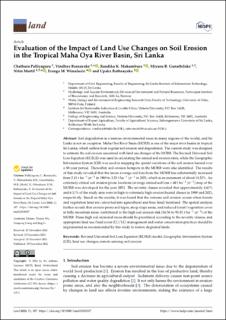| dc.contributor.author | Palliyaguru, Chathura | |
| dc.contributor.author | Basnayake, Vindhya | |
| dc.contributor.author | Makumbura, Randika K. | |
| dc.contributor.author | Gunathilake, Miyuru | |
| dc.contributor.author | Muttil, Nitin | |
| dc.contributor.author | Wimalasiri, Eranga M. | |
| dc.contributor.author | Rathnayake, Upaka | |
| dc.date.accessioned | 2023-09-27T11:50:03Z | |
| dc.date.available | 2023-09-27T11:50:03Z | |
| dc.date.created | 2023-01-19T20:25:33Z | |
| dc.date.issued | 2022-12-29 | |
| dc.identifier.citation | Land. 2023, 12 (1), 1-33. | en_US |
| dc.identifier.issn | 2073-445X | |
| dc.identifier.uri | https://hdl.handle.net/11250/3092394 | |
| dc.description.abstract | Soil degradation is a serious environmental issue in many regions of the world, and Sri Lanka is not an exception. Maha Oya River Basin (MORB) is one of the major river basins in tropical Sri Lanka, which suffers from regular soil erosion and degradation. The current study was designed to estimate the soil erosion associated with land use changes of the MORB. The Revised Universal Soil Loss Equation (RUSLE) was used in calculating the annual soil erosion rates, while the Geographic Information System (GIS) was used in mapping the spatial variations of the soil erosion hazard over a 30-year period. Thereafter, soil erosion hotspots in the MORB were also identified. The results of this study revealed that the mean average soil loss from the MORB has substantially increased from 2.81 t ha−1 yr−1 in 1989 to 3.21 t ha−1 yr−1 in 2021, which is an increment of about 14.23%. An extremely critical soil erosion-prone locations (average annual soil loss > 60 t ha−1 yr−1) map of the MORB was developed for the year 2021. The severity classes revealed that approximately 4.61% and 6.11% of the study area were in high to extremely high erosion hazard classes in 1989 and 2021, respectively. Based on the results, it was found that the extreme soil erosion occurs when forests and vegetation land are converted into agricultural and bare land/farmland. The spatial analysis further reveals that erosion-prone soil types, steep slope areas, and reduced forest/vegetation cover in hilly mountain areas contributed to the high soil erosion risk (16.56 to 91.01 t ha−1 yr−1) of the MORB. These high soil erosional areas should be prioritized according to the severity classes, and appropriate land use/land cover (LU/LC) management and water conservation practices should be implemented as recommended by this study to restore degraded lands. | en_US |
| dc.language.iso | eng | en_US |
| dc.publisher | MDPI | en_US |
| dc.rights | Navngivelse 4.0 Internasjonal | * |
| dc.rights.uri | http://creativecommons.org/licenses/by/4.0/deed.no | * |
| dc.title | Evaluation of the Impact of Land Use Changes on Soil Erosion in the Tropical Maha Oya River Basin, Sri Lanka | en_US |
| dc.type | Peer reviewed | en_US |
| dc.type | Journal article | en_US |
| dc.description.version | publishedVersion | en_US |
| dc.rights.holder | © 2022 by the authors | en_US |
| dc.source.pagenumber | 1-33 | en_US |
| dc.source.volume | 12 | en_US |
| dc.source.journal | Land | en_US |
| dc.source.issue | 1 | en_US |
| dc.identifier.doi | 10.3390/land12010107 | |
| dc.identifier.cristin | 2110902 | |
| dc.source.articlenumber | 107 | en_US |
| cristin.ispublished | true | |
| cristin.fulltext | original | |
| cristin.qualitycode | 1 | |

